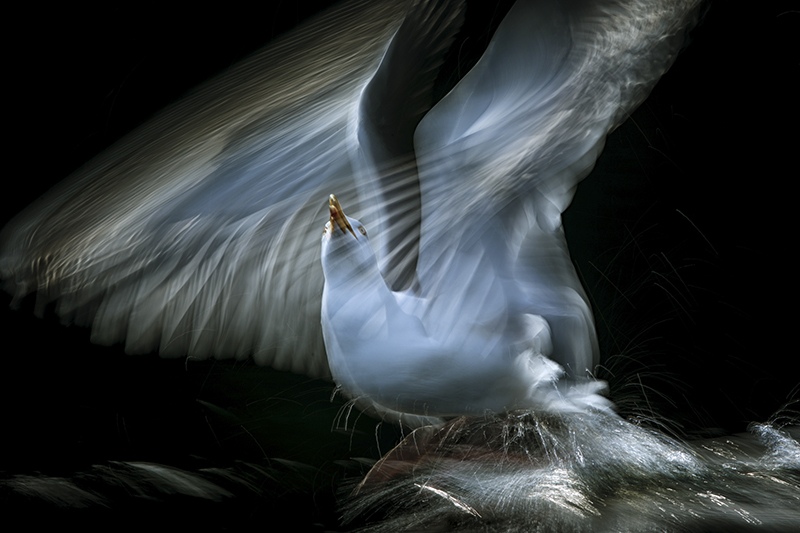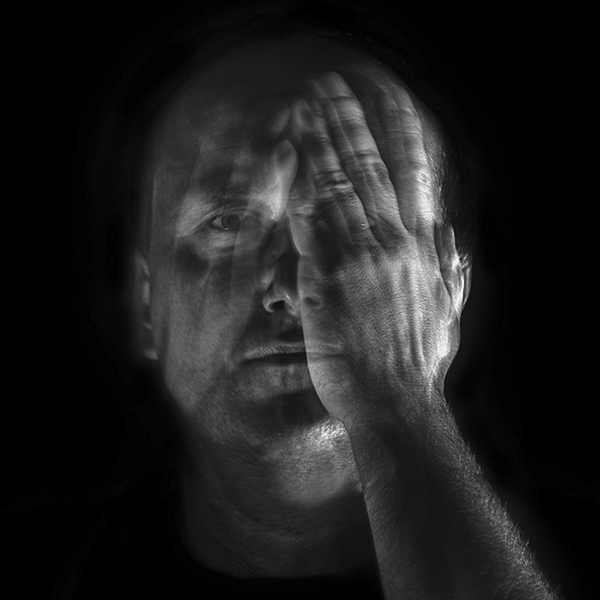
Capturing Poetic Motion: Jiří Hřebíček's Artistic Vision in Wildlife Photography
In a stunning blend of artistry and wildlife photography, Jiří Hřebíček’s work captures the poetic essence of nature. His recent victory at the Wildlife Photographer of the Year competition, where his piece The Artful Crow earned top honors in the Natural Artistry category, showcases his exceptional talent for portraying the spirit of the wild with a lens that beautifully balances technical precision and artistic interpretation.
Hřebíček’s unique style emerges from his inventive use of movement and light, employing Intentional Camera Movement (ICM) during long exposures. This approach transforms traditional wildlife photography into ethereal, impressionistic compositions. By prioritizing atmosphere and emotion over sharp detail, he crafts painterly scenes that flow with energy, breaking away from conventional wildlife imagery.
His work embodies a harmony of careful planning and spontaneous creativity. Meticulously composed scenes come alive with unpredictable natural movement. Through experimental use of color, light, and shadow, Hřebíček creates textured compositions that reflect the fleeting rhythms of nature. This delicate balance introduces an evocative sense of melancholy, inviting viewers into an emotional and contemplative experience.
We are thrilled to interview this innovative artist, whose dynamic approach and insightful perspective open up a refreshing dialogue on the intersection of nature and artistic expression.
Q: Can you tell us about the moment or experience that first sparked your passion for wildlife photography, particularly birds?
A: My passion for wildlife photography began quite early, around six or seven years old. My grandfather gave me my first books about nature and wildlife. I was especially fascinated by a book about animals that were newly discovered in the 20th century, like Komodo dragons in Indonesia and okapis in Africa. This sense of mystery in nature inspired me to explore more about the natural world and animals.
This interest led me to study zoology and ecology at the university. I even spent two or three years working as a scientist. However, at that time in the Czech Republic, conditions for young scientists weren’t as favorable as they are now, so I eventually decided to switch to the private sector and didn’t return to biology professionally.
When I started with wildlife photography, it felt like an obvious and perfect fit for my love and appreciation of nature. Even though I’m now beginning to broaden my focus to landscapes and people, wildlife remains closest to my heart. Interestingly, I didn’t like birds that much during university because I had trouble distinguishing between species. But when I began photography, I realized they are perfect subjects from an aesthetic point of view. Practically speaking, when you go to a park or look around, 99% of the animals you’ll encounter are birds, not mammals or reptiles. Birds are the most common animals around us, making them accessible subjects for photography.
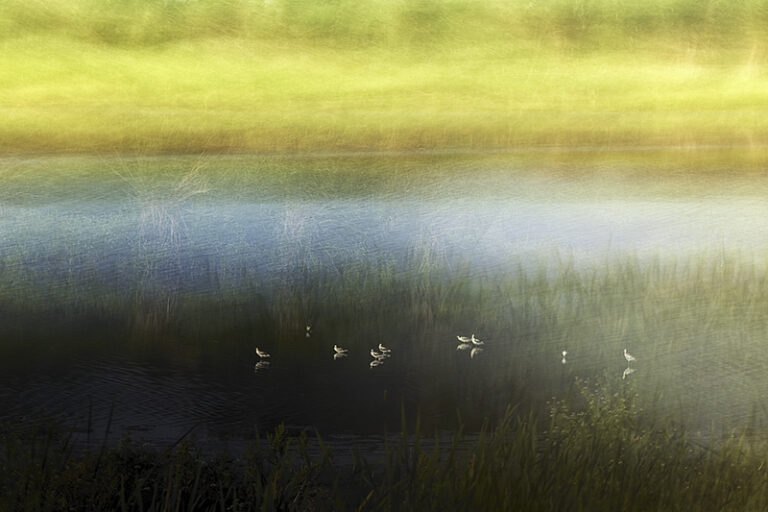
Q: How did you develop your distinctive photographic style that blends impressionism and abstraction using intentional camera movement?
A: When I started, I focused on traditional wildlife photography and was quite happy when I managed to get images that looked like postcards or National Geographic-style shots. However, after a few years, I realized that when I traveled with friends—usually groups of three to six—we all returned with more or less the same pictures. This wasn’t what I wanted. For me, photography is an artistic medium that should allow us to be creative and express something personal.
I wanted to capture something more personalized and put something of myself into my photos. I struggled with how to achieve this without switching to a different field. Many people expect nature and wildlife photography to present reality, so experimenting with artistic techniques can sometimes lead to misunderstanding or even criticism.
Then I vividly remember discovering the work of a photographer from the Netherlands, whose pictures of African wildlife looked like impressionistic paintings. I realized he was using the technique of Intentional Camera Movement (ICM). I was fascinated by this approach and thought that if I liked these images, perhaps I would enjoy creating them myself.
I started experimenting with ICM, and after a few weeks, I realized that this was the direction I wanted to pursue. That was about eight years ago, and I’ve become increasingly dedicated to this style. It opened up a completely new universe for me with endless opportunities. Even if you’re in the same spot with the same people, you’ll always get unique or at least different pictures.
I also noticed that while many photographers use ICM occasionally to enrich their portfolios, they don’t fully embrace it. In contrast, I decided to commit almost entirely to this technique—perhaps 95% of my work involves intentional blurring, with only a small portion being sharp. This is the complete opposite of the traditional approach, but it allows me to express my artistic vision and create images that are uniquely my own.
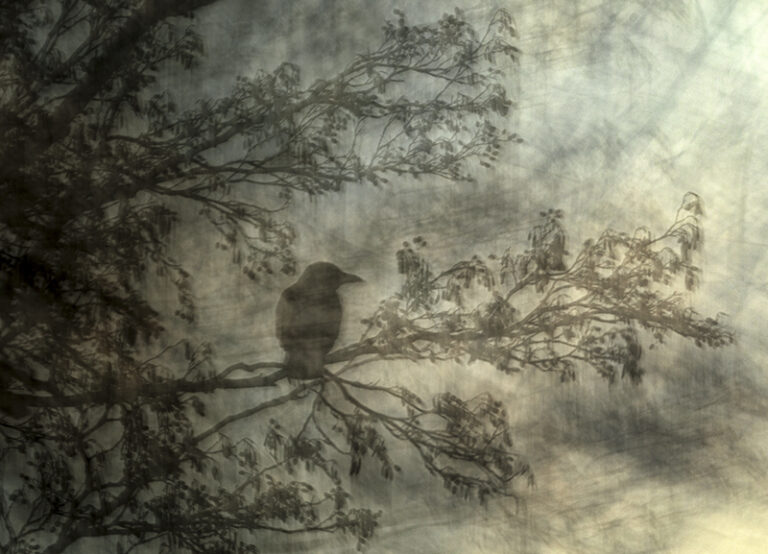
Q: Your image “The Artful Crow” won the Natural Artistry category at this year’s Wildlife Photographer of the Year. Can you tell us about the inspiration behind that photo and what the win means to you?
A: Absolutely! I’m thrilled that “The Artful Crow” has been recognized—it truly looks like a painting, doesn’t it? I often describe my work as painting with light, using my camera much like a painter uses a brush.
For this particular image, I utilized the Intentional Camera Movement (ICM) technique. Typically, ICM is used with moving subjects like flying birds or running animals. This method, often called panning, involves following the subject with your camera to keep the moving subject sharp while the background blurs. However, in this case, the crow was stationary, and I initially thought I couldn’t apply ICM since the bird wasn’t moving.
Then I realized that if the subject isn’t moving, I can create motion by moving the camera more deliberately. I used a longer shutter speed—about two seconds. I clicked the shutter, kept the camera still for a brief moment, and then quickly moved it elsewhere. With approximately 1.5 seconds remaining in the exposure, I began moving the camera to achieve that impressionistic, painting-like effect.
All my images are created entirely in-camera; I don’t use multiple exposures or stacking. People often ask how much Photoshop I use, and I tell them none of these images are Photoshopped. This authenticity is important, especially for competitions that require original RAW files.
When preparing for exhibitions, I prefer printing my photographs on canvas rather than photo paper. Sometimes people see my work without knowing I’m the photographer and ask, “Who painted this?” It’s delightful to tell them, “Actually, this is a photograph.” Winning this award means a lot to me because it validates my artistic approach and encourages me to continue exploring this unique style.
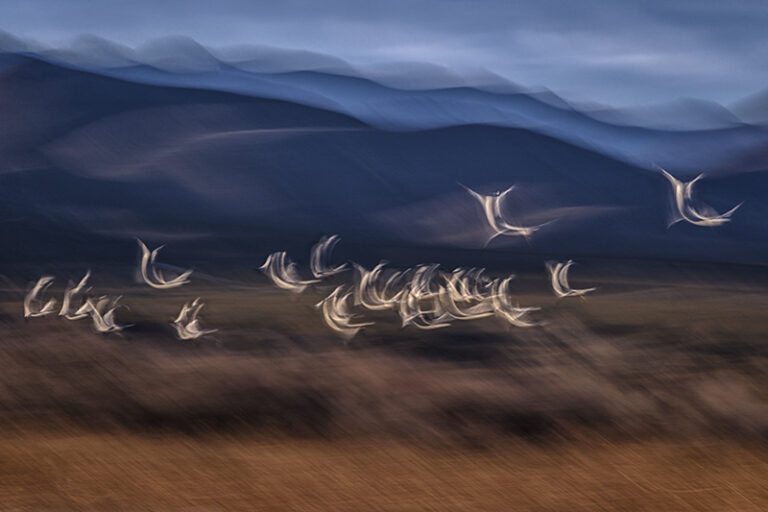
Q: Your photos often reflect the motion and freedom of birds. How do you visualize and capture that sense of movement in your work, creating another dimension?
A: Interestingly, during my university studies, I didn’t particularly like birds. In ornithology classes, distinguishing between so many species and taking exams was challenging for me. I even studied entomology, which involved recognizing countless insects—perhaps even more difficult!
However, when I started photography, I realized the dynamic nature of birds—their movement and flight—is truly amazing. Traditional photography often freezes the moment, but I wanted to capture more than that. When I discovered the Intentional Camera Movement (ICM) technique, it became a perfect fit. With ICM, the bird is moving, and you’re moving slightly with the camera, allowing you to capture what I call “the spirit of the bird.” You find something in the image that your human eye didn’t even see at the moment—it existed briefly, and you captured it.
The combination of the bird’s movement, long shutter speed, and intentional camera movement creates really abstract motifs from nature and birds. This is what I still love about it.
For example, I have a picture where a bird was on the surface of the sea and began to take off. In the image, the bird appears almost static, but the movement of its wings created an effect that looks like a curtain. In another photograph, the sun was shining on the scene, and the movement of one wing created a shadow effect—you can see the shadow of the bird’s head on the motion of its wing. Capturing these kinds of unexpected and fleeting moments continues to fascinate me and drives my passion for this style of photography.
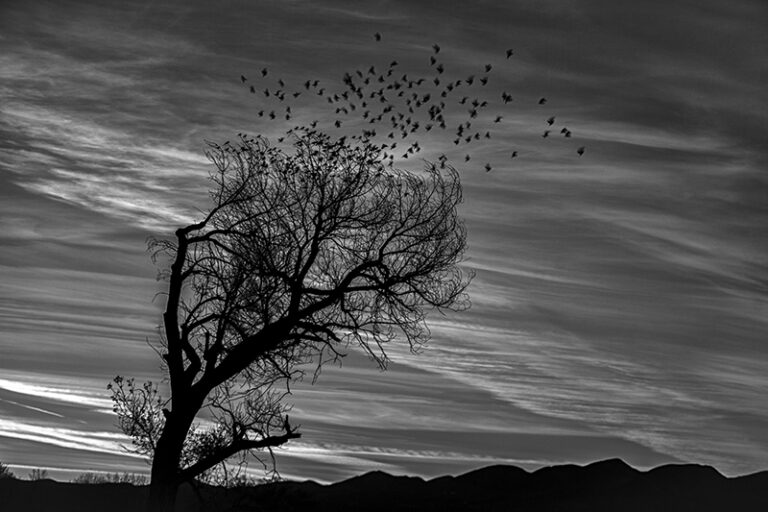
Q: The elements of nature play important roles in your images. In “Leaving,” one of your award-winning photographs, the birds are departing from a tree. It seems that with your technique, you’ve captured the essence of nature very well. Can you tell us more about this image?
A: Certainly! What immediately strikes me and what I pay close attention to is the ability to combine static elements with movement. It’s not always about having everything blurred. In “Leaving,” I focused on the birds leaving the tree, which is why I named it that. The photograph was taken at Bosque del Apache in New Mexico, one of my favorite places—even though I’ve been there only once.
I initially went there because the area is known for migrating sandhill cranes and snow geese. However, these particular birds were red-winged blackbirds or a similar species. They moved in flocks, constantly shifting from one tree to another. I wanted to capture the moment when, at first glance, the birds perched on the tree seemed like part of it, almost indistinguishable from the branches. Then suddenly, they take off, and it’s as if the tree is losing its leaves.
This movement reminded me of a fog or mist enveloping the tree. Witnessing and capturing that moment was amazing. The combination of the static tree and the dynamic flock of birds creates a compelling image that highlights the transient beauty of nature. My technique allowed me to blend these elements seamlessly, capturing not just a scene but a fleeting experience.
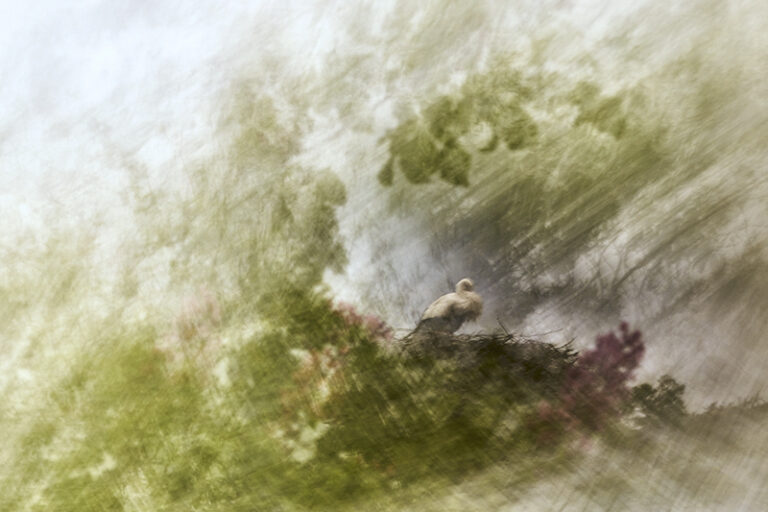
Q: You mention letting your imagination run riot in creating painting-like photos. Can you elaborate on the techniques you use to achieve this artistic effect?
A: Certainly! I believe the Intentional Camera Movement (ICM) technique is as old as photography itself. While modern photographers often focus on sharpness and advanced stabilization systems, I’m drawn to the opposite approach—creating artistic images using longer shutter speeds. ICM involves deliberately moving the camera during exposure to achieve various creative effects.
One basic method is panning, where I set the exposure time—perhaps from 1/30 to 1/50 of a second, depending on the subject’s size, distance, and speed—and follow the movement of the animal or bird. This keeps the moving subject relatively sharp while blurring the background.
Another technique involves combining static elements with movement. For example, keeping the camera still to capture a sharp tree while birds move around it, creating a blurred effect. This isn’t traditional ICM since the camera isn’t moving, but it achieves a similar artistic outcome by blending sharp and blurred elements.
I also enjoy photographing reflections on water surfaces. Capturing just the reflection of a forest with colorful autumn foliage on a lake can result in an impressionistic image without any camera movement. The natural blending of colors and textures creates a painterly effect.
Recently, I’ve been exploring more complex techniques with static subjects. I might keep the camera still initially to capture the main subject, then quickly move the camera to incorporate other elements. For instance, I could capture the colors of a sunset sky and then move to gather textures from different areas around me. This approach requires thinking beyond what’s in the viewfinder, considering the lights, shadows, and textures that can be combined. It’s more complex but offers better control over the final image because I decide how long to collect certain colors or lights.
Using a digital camera is essential for this process because it involves taking many shots—you can’t usually achieve the desired effect in one attempt. It’s a trial-and-error method where you adjust movements based on the initial results. Understanding how each movement affects the image comes with experience. The more you practice, the better you become at predicting and controlling the outcome. By letting my imagination run wild and experimenting with these techniques, I’m able to create images that resemble impressionistic paintings, capturing not just a moment but the essence and emotion of the scene.
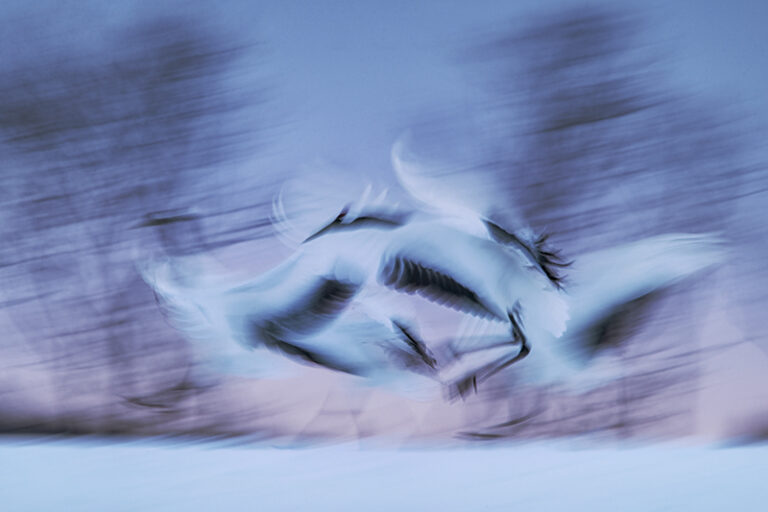
Q: Your work has been published in renowned photography books and exhibited internationally. What does it mean to you to have your art recognized on such a large scale?
A: I’m always deeply honored and grateful when my photos receive awards, especially in prestigious competitions like Wildlife Photographer of the Year. However, there are a few things that mean even more to me than winning competitions.
One of the greatest recognitions is when someone tells me that among many photos, they can always recognize mine. For me, this is the best acknowledgment because it means I’ve been able to put my own signature, my emotions, and a piece of myself into my pictures, making them stand out among others.
Another meaningful aspect is when people want to learn from me. It’s amazing when individuals approach me seeking guidance because they admire my work and wish to create something similar but don’t know how. Being able to support and inspire others in their creative journey is incredibly rewarding.
Lastly, when people purchase my prints to decorate their homes, it touches me deeply. Knowing that someone wants to have something of mine in their personal space means a lot to me.
These three forms of recognition—having my work be identifiable, inspiring others to learn, and people choosing to live with my art—mean even more to me than winning in competitions. They affirm that my art resonates with others on a personal level, which is incredibly fulfilling.
Q: Are there any photographers or artists whose work has inspired or influenced your photography style?
A: Yes, two photographers have significantly influenced my work.
The first is a Dutch photographer named Jan van der Greef, who has been creating ICM images for many years. He inspired me to start experimenting with this technique. Interestingly, after seeing his pictures, I wanted to try ICM myself. On my next trip to Hokkaido, Japan, I began experimenting with the technique. During one evening, I took a photograph called “The Dance,” which I mentioned earlier. It was captured on my very first evening using ICM, and it still means a lot to me.
The strange thing is that the day after, I was at another location crowded with photographers, mainly from Japan. I decided to walk away to find a place where I could experiment on my own. I reached a viewpoint—a little meadow by the river—and suddenly, Jan van der Greef was there with his wife! I couldn’t believe it. I had just been inspired by his work, and there he was. I didn’t dare to talk to him at first, but fortunately, his wife initiated a conversation by asking where I was from. We started talking, and I showed him some of my first ICM attempts. He gave me valuable advice on how to work with the technique. We even agreed to meet again and went on another trip to Norway a few months later. I learned a lot from him.
The second photographer is a Swedish artist named Erik Malm. Recently, as I started exploring ICM techniques for static scenes, I discovered his work. He has been doing exactly this for over 20 years, so he’s far ahead in the field. I’m inspired by studying his photos and trying to understand how he achieves his results—his movements and techniques. These two photographers have influenced my work the most.
However, what I appreciate about this technique is that you can’t replicate someone else’s work exactly. You can’t just copy and paste or duplicate someone’s style. You have to do it your own way, and the results will always be unique.
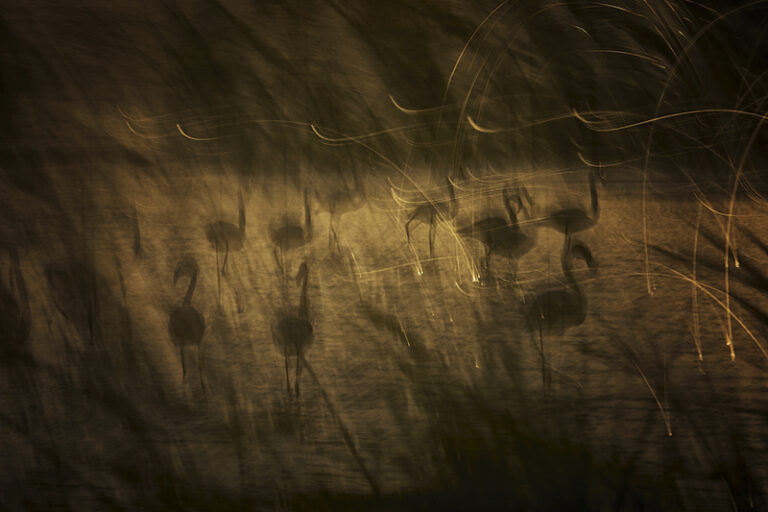
Q: Many of your photos have a strong artistic quality. How do you balance the technical aspects of photography with the emotional or imaginative elements you bring into your work?
A: There’s not much to balance because, for me, art definitely prevails. This technique has liberated me from the technical aspects of photography since I’m not a particularly technical person. There are always new features and advancements in cameras, but I don’t focus on them—they’re not really for me.
I’m usually out of the loop in discussions about camera specifications like megapixels. If someone asks me, I often don’t know; sometimes it’s even a bit embarrassing. For instance, during the Wildlife Photographer of the Year event in London, someone asked me which camera model I use. I knew it was a Canon, but I couldn’t recall the exact model—whether it’s the R5 or 5R. Remembering the model isn’t important to me.
For me, it’s about setting up the camera for the Intentional Camera Movement (ICM) technique. This means adjusting settings like lowering the ISO to 100 or even to 50, depending on the conditions. I’m really just using the information around me—painting with light and using the camera like a painter’s brush.
Nowadays, since some of my new pictures are sharper and more static, I do need some elements to be sharp. In these cases, a good stabilization system in the new cameras helps me achieve this. But otherwise, I start moving the camera to create the effects I want. So, the technical aspect isn’t that relevant for me; it’s more about the artistic expression.
Q: Did your traveling experience help you in finding the right locations to shoot birds? Was it important to you, or do you focus more on local areas?
A: Initially, traveling was important to me because I believed I needed to visit specific places to find the right subjects. For my technique, I require cooperative birds or animals that aren’t too shy. Waiting in a forest for an elusive, rare animal that might appear for just a few seconds after days of waiting isn’t ideal for my creative process. I need birds flying around me almost constantly so I can experiment with settings and techniques.
I chose places where I could have that opportunity. For example, Bosque del Apache in the U.S. was one of the first places I visited because it has thousands of animals and birds. In Europe, I enjoy the Camargue region, where wild flamingos allow you to get quite close—they’re patient subjects. There’s also a spot in Norway where you can photograph sea eagles, seagulls, and white-tailed eagles, which is another favorite of mine.
However, a few years ago, I became ill and couldn’t travel at all for about a year and a half. At first, I was frustrated by this situation, but since it coincided with the time I was discovering the ICM technique, I decided to use my newfound free time to explore my local surroundings. I started visiting parks and zoos—initially for practice and training purposes—but now I genuinely enjoy it. There’s still so much to discover and experiment with close to home.
This experience taught me that you don’t have to travel far to find interesting subjects. Sometimes, the most captivating opportunities are right in your neighborhood.

Q: That’s good to know, but are there any future places you would like to go to shoot your next project? Any places you have in mind?
A: Yes, I have booked a few trips to the Galapagos Islands. When I first started traveling, the Galapagos was one of the first places I visited, but I didn’t take any pictures there at the time. I want to go back now to try using the ICM technique in that unique environment.
Another place I’d like to visit is the Himalayas to see snow leopards. I might not photograph them extensively, but experiencing them in their natural habitat is something I have in mind. It’s not planned yet, but I would love to go there in the future.
Q: There is an element of mysticism in some of your photographic representations. What does this mysticism represent for you, and how do you incorporate it into your work?
A: It’s interesting that you perceive an element of mysticism in my photos because I feel that as well. I consider myself a melancholic person, and this often reflects in my work. Whether it’s through paintings, poems, or when I used to play in a musical band—which was also inclined towards dark music—there’s always been a depth and moodiness in my creative expressions.
When I started photography, I initially captured common subjects like hummingbirds and colorful motifs. However, over time, I noticed that even when photographing ordinary birds, the mood of the images leaned towards a certain glow or melancholy. I found myself repeatedly naming my pictures “Lonely,” “Loneliness,” or “Solitude.” Sometimes I’d want to use the same title again and realize I already had a photo with that name. This made me realize that a melancholic theme was a recurring motif in my work.
I’m not sure if I would specifically label it as mysticism, but there is certainly a profound emotional element infused into my photographs. Sometimes, I’m even surprised by what emerges from within me and manifests in my art.
An interesting experience highlighted this for me. I have a photograph called “The Birds,” inspired by Hitchcock’s movie. To me, it’s dramatic and haunting. Recently, a friend wanted to hang this picture above her bed. I was surprised and asked why she chose such a seemingly depressive motif. She told me that she felt it was positive—the horizon and the light from the sunset symbolized hope and a new beginning for her.
This made me realize that my images provide ample space for viewers’ own imagination. People can interpret them from their perspectives. While I might see an image as melancholic or negative, someone else might perceive it as positive and uplifting. This duality adds another layer to my work, allowing it to resonate differently with each person.
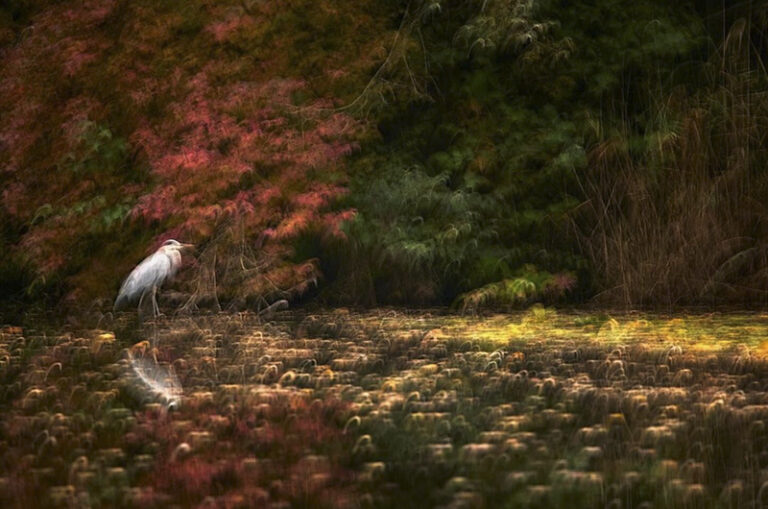
Q: With such an impressive list of accolades, do you have a favorite photograph or a specific project that holds special meaning for you?
A: Yes, I believe I mentioned it briefly earlier. For me, a very special photograph is called “The Dance.” This was literally one of the first images I took using the Intentional Camera Movement (ICM) technique and the first one I edited. The day after capturing this image, I met the photographer Jan van der Greef, who had inspired me to explore this technique. So, this photograph holds a special place in my heart as it marks the beginning of my journey into this style.
Another favorite is a photograph I took with Jan when we were in Norway. It’s of a seagull taking off from the water surface, where the wings appear like curtains due to the motion captured. This image is particularly meaningful to me—it even graces the cover of my first book, which I published last year.
Additionally, the photograph of the crow, for which I was recently awarded, is very special to me. It truly represents my feelings of solitude and melancholy. These kinds of images are more private and personal for me. Sometimes I’m surprised that others appreciate them because I often take them for myself. However, I do enjoy sharing my work, so I’m not taking these pictures just to keep them hidden away.
So, these photographs—”The Dance,” the seagull image from Norway, and the awarded crow—are particularly special to me because they represent important moments in my artistic journey and convey deep personal emotions.
Q: What advice would you give to aspiring wildlife photographers, especially those looking to combine art and nature in their work?
A: My advice would be to embrace experimentation—don’t be afraid to try different camera settings and techniques, and don’t hesitate to stand out. Start by exploring your own surroundings; there are always subjects and scenes nearby where you can practice. You don’t need to travel far to find inspiration or improve your skills. Most importantly, enjoy the process—have fun taking photos and spending time in nature.
I believe it’s our main role as nature and wildlife photographers to capture and showcase the beauty of nature, inspiring others to protect it for our children and future generations.
Conclusion
Jiří Hřebíček’s journey in wildlife photography exemplifies the harmonious blend of art and nature through his innovative use of Intentional Camera Movement (ICM). By embracing experimentation and allowing his imagination to guide him, he captures the spirit and emotion of wildlife in ways that transcend traditional photography, creating images that are both visually stunning and emotionally resonant. His work challenges conventional norms by prioritizing personal expression over technical precision, inspiring others to explore their creativity and deepen their connection with the natural world. Through his evocative photographs, Hřebíček fulfills a greater purpose: showcasing the beauty of nature to inspire its protection for future generations.
Hřebíček’s Website and Instagram
